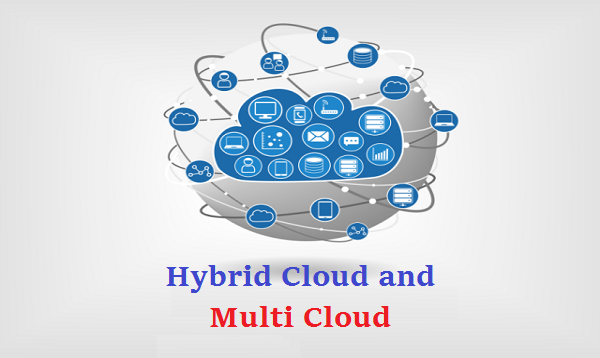While multi cloud is a term that is being used extensively today, many people are not sure whether it is the same as a hybrid cloud. Although both these models of cloud hosting may be related closely, they are certainly not one and the same thing.
What are a hybrid cloud and a multi cloud?
The hybrid cloud refers to a mix of private and public clouds; it basically connects a pubic cloud to an on-site infrastructure and they are designed to run together to complete a specific task. So, you optimize the workloads to ensure that it operates in the right environment, and for this, you may need more than a single cloud infrastructure.
But a multi cloud is different where you will actually use multiple clouds from different providers for different types of tasks. This strategy is necessary because a certain department may need the cloud for document sharing while another department may require the cloud for Big Data analytics. Both departments have different requirements but both require cloud solutions. So, satisfying the needs of both these departments may require more than a single provider and this is why a multi cloud model becomes necessary. You will find that there are companies which turn towards a multi cloud to prevent vendor lock-ins. They are also keen to get new technologies from multiple vendors instead of just one.
What is the key difference between a hybrid cloud and a multi cloud?
The prime difference between these two models lies in their deployment strategies for performing one task. In a hybrid cloud, data can intermix between the on-site and public cloud, but it will stay with a single workload. However, in a multi cloud, many providers will be needed to perform multiple tasks, either within one department or multiple departments. So, the multi cloud strategy may even include a hybrid cloud, but the reverse is not always true. In a multi cloud, you will mix and match various cloud provider solutions obtained from various cloud service providers. These are meant to satisfy different workload needs. So, the multi cloud focuses more on implementing or managing clouds while the hybrid cloud model focuses on the underlying technology.
According to Begeny who is channel manager at DSM Technology Consultants, the multi cloud is primarily a strategy and it involves multiple vendors. Begeny believes that the hybrid cloud is essentially the mixture of both on-site (private) clouds and public clouds which allow CIOs to shuttle workloads to the correct environments at the correct times, according to the specific business needs.
Since the terms are quite confusing for the common man, Ed Featherson, the main architect of Cloud Technology Partners, feels that the hybrid cloud is basically anything inside a public cloud which continues to integrate or exchange data with systems which are not a part of this cloud. The multi cloud, according to him, is a type of hybrid cloud but it denotes operations in multiple public clouds, mainly for avoiding lock-ins to a single vendor. Most CIOs are actually trying to implement the multi cloud strategy in association with the hybrid cloud. They want to be able to use the maximum potential of clouds and they are keen to offer their staff maximum flexibility and control of their workloads.
Why is a multi cloud strategy preferred?
Using a multi cloud strategy, businesses can meet specific application requirements and take care of specific workloads. This is made possible because they can get different services from different vendors. This is necessary as all departments are not likely to have the same workload or application needs. The IT teams may also find this strategy useful because of its geographical benefits, for mainly addressing latency issues.
Unlike the hybrid cloud, the multi cloud strategy can avoid vendor lock-ins so as to avoid any single point of failure. It is possible to minimize downtimes because businesses can employ this strategy to get unique services from different CSPs. The truth is, while the security issues concerning public clouds are slowly fading, concerns about the vendor lock-in are slowly increasing. The best way to mitigate vendor lock-in risks is to deploy the multi cloud strategy. Begeny therefore argues in favor of this strategy, however stating at the same time that the biggest benefit undoubtedly is the higher agility and flexibility which it offers to businesses.
When the businesses need to undergo changes, the clouds can change along with them if there is a multi cloud strategy. Not only is this strategy for business enablement, it is also for taking IT forward. Technologies and clouds are changing dramatically; when you get locked down, you cannot grow seamlessly. But if this can be avoided, businesses can grow along with the new technologies. They will get far more options to grow further.
For Interesting Topic : What Is Hybrid Cloud Hosting?






 Live Chat
Live Chat

